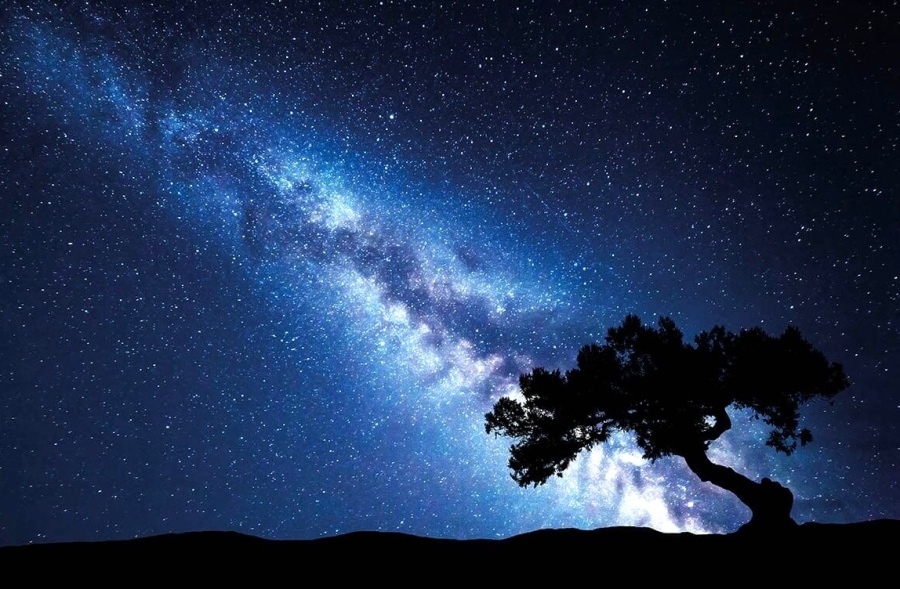“Suppose the beginning of the universe was like the South Pole … to ask what happened before the beginning of the universe would become a meaningless question, because there is nothing south of the South Pole.”
— Stephen Hawking
South of South: The Beginning of Our Universe
The term “The Big Bang” is commonplace. But like A.I. generated art, the idea’s first impression is alluring while its deeper implications and purpose confound everybody. The more we consider the idea, the more we ask ourselves, “what the hell is this?”
To grossly oversimplify for lay people—including myself—the theory* is that the spacetime of our universe was once condensed into a singular point (the singularity). Spacetime has since, and is still, expanding. After billions of years of runaway chemistry, subatomic particles have bonded into states which make up the universe as we see it today. The full truth is more complex, having to do with our universe either being flat or only appearing flat, quantum mechanics as it relates to relativity, the non-emptiness of empty space, and other factors which I’m incapable of incorporating correctly into my hypothesis. But if the age of the internet has taught us anything, it’s that being a complete non-expert on a subject should have no bearing on how often or with what authority we insert ourselves into conversations about that topic.
Sticking with my simple definition of the Big Bang, a conundrum still arises: why did spacetime expand? This conundrum has teased scientists and the general public alike, but fear not! A rando on the internet (me) will explain! Let’s first consider how a singularity would have affected the “time” aspect of “spacetime.”
Anyone who’s seen Christoper Nolan’s 2014 blockbuster Interstellar is likely familiar with the concept of how gravity affects time. The denser an object, the stronger its gravitational force; the stronger the gravitational force, the more it pulls on the flow of time, thus “slowing down” time (another gross oversimplification, but as implied, I’m not an astrophysicist). This concept may seem dressed in all the best drag of science fiction, but it is a core aspect of Einstein’s famous Theory of Relativity. In fact, the GPS in your phone must account for the relativity of time in order to function accurately. Amazing! But let’s take this knowledge of “time is malleable” and apply it to our universe’s “beginning.”
In the beginning was a body of mass so dense that its gravitational force was functionally “infinite.” And under this infinite force, all the laws of physics broke down from their currently-understood constants and merged into a homogenous soup of “physic.” A definition from Universe Today phrases it, “[A singularity] is a point in which all physical laws are indistinguishable from one another, where space and time are no longer interrelated realities, but merge indistinguishably and cease to have any independent meaning.” Trippy—brain breaking even, but like a supermodel recovering from a trip on the runway, let’s march fiercely onward as though we hadn’t just broken our intellectual ankle.
But wait, if gravity and spacetime were indistinguishable, and gravity slows time down, does that mean that an infinite gravitational force, in order to become one with spacetime, would have to infinitely slow down time? If yes, wouldn’t infinitely slow time mean that time is not moving? And if time is not moving, does it even exist?
Herein lies the “trick” of infinity. Infinity—as far as we know—doesn’t exist. It is a placeholder for numbers so large (or small) they might as well go on for forever. Our use of “infinity” is much like the way we say that Pi is 3.14. Pi is NOT 3.14, but lunch starts in five minutes, so close enough. In our singularity, time is only almost at a stand still. And since the laws of physics cannot condense down into an infinitely homogeneous soup, then perhaps our singularity never was—or never could have been—infinitely (perfectly) stable.
At some “time” the gravitational center of the singularity, not being infinitely stable, is pushed by a few bouncing particles a bit to the left (whichever direction is “left” in space). Remember, if infinity is not possible, time cannot ever come to a full stop, thus our bouncing particles are allowed to do something that takes time, like bounce. Gravity, being gravity, begins attracting matter to this new, slightly off center, center of gravity. The more matter is pulled off center, the more unstable our singularity becomes. The instability increases exponentially until, bang, the singularity rips itself apart; and just like the Voyager spacecraft using Jupiter’s gravity as a slingshot, the gravity of the singularity slingshots matter out into the universe. Gravity is stretched and, necessarily, spacetime stretches (or expands) as well.
The fact that “infinity” cannot be possible is the very concept that necessitates the expansion or “beginning” of our current universe. Because “infinite” density cannot actually be achieved, true gravitational stability of the infinite singularity is an impossibility. Spacetime must expand—our current universe must begin.
At the North Pole, Every Direction is South: What’s “The End”?
Like a 1990’s point-and-click adventure, our solution to one puzzle has brought us to another, seemingly more obtuse puzzle: If infinity is impossible, the singularity can only be near infinitely old. Why did our universe not begin sooner (14 billion years, relative to near-infinity, isn’t so long a time)?
Fortunately for us, life is not like a 1990’s point-and-click. There is no insane “moon logic” to deal with; reality functions how it functions, and logical processes can be inferred and tested (admittedly, neither the universe nor the point-and-clicks of the early ’90s seem to give a damn about human intuition). So is there a reasonable extrapolation for why the universe began? I propose, yes.
Time, as we experience it, is part of the “fabric” of the universe, part of spacetime. The reason time moves at different speeds depending on the gravitational force is because gravity is “bending” spacetime. And if the universe is made of spacetime, all the matter in the universe must be bending the entire plane of spacetime. But as the universe expands outward (as we know it is), is it possible for the bending of spacetime to completely flatten? Our current, relatively young universe already appears flat, though we aren’t sure if the appearance is the whole picture.
Imagine that the bending of spacetime can be measured in units of whatever aspect of gravity bends spacetime (“bendy units” or “BUs”). The farther that matter expands outward, the lower the number of BUs, and the weaker the force of gravity affecting spacetime. The weaker the force of gravity, the faster matter propels away from matter as time speeds up due to the unbending of spacetime.
Imagine that 100 BUs represents a truly infinite singularity, which would be stable. That’s impossible. So shouldn’t 0 BUs, an infinitely spread out universe, also be impossible?
If the fabric of spacetime cannot be fully unbent, cannot become perfectly flat, then our universe must remain spherical—or some other, non-infinitely-flat shape—in composition. Considering the size of the universe, perhaps the reason we see the whole of spacetime as essentially flat is the same reason early humans saw the Earth as essentially flat; they were too small, relative to the planet, to notice any curve in the plane as a whole. If the observable universe is giving us the same “flat horizon” illusion, if the fabric of spacetime is curved, we have no reason to believe that the curve won’t cause spacetime to circle back in on itself. Much like traveling in a straight line on a globe, you will end up where you started; you can only travel so far north before you begin traveling south again. In doing this, I propose that the beginning moment of the universe and the final moment of the universe are the same point in space and time.
The “bang” of our universe was not only its beginning, but its end.
Conclusion
Again, I am no astrophysicist, nor do I have the mathematical knowledge needed to begin even a cursory exploration of my hypotheses, but I put them forward here for a reason. These hypotheses are a celebration of what our minds can do. Despite our ape brains still reeling from fear of noises in the dark, those same brains have adapted an incredible ability to think, reason, and imagine. We are scientifically minded beings, and being “just a layperson” is a terrible reason to avoid seriously pondering how and why our reality functions the way it does. Science is not a practice accessible only to those in the tallest ivory towers; science—following the curiosity that drives us to understand the reality in which we live—is the birthright of humanity.
I propose that we all embrace our birthright to the fullest of our abilities.
. . .
Disclaimer: As I hope was sufficiently implied in the text, this article is speculation based on my own enthusiasm for pondering the makeup of reality, and is not intended as an accurate representation of what astrophysicists and cosmologists have discovered about our universe.
For a real explanation of these topics, check out A Universe from Nothing by Lawrence Kraus, and Astrophysics for People in a Hurry by Neil deGrasse Tyson.
*”A Theory” in science refers to the best, most vigorously tested collection of facts—which together can predict further discoveries—we have for an aspect of observed reality. It does not mean “guess,” as the word “theory” is used in everyday speech.
Cover Image property of Geographical Magazine










